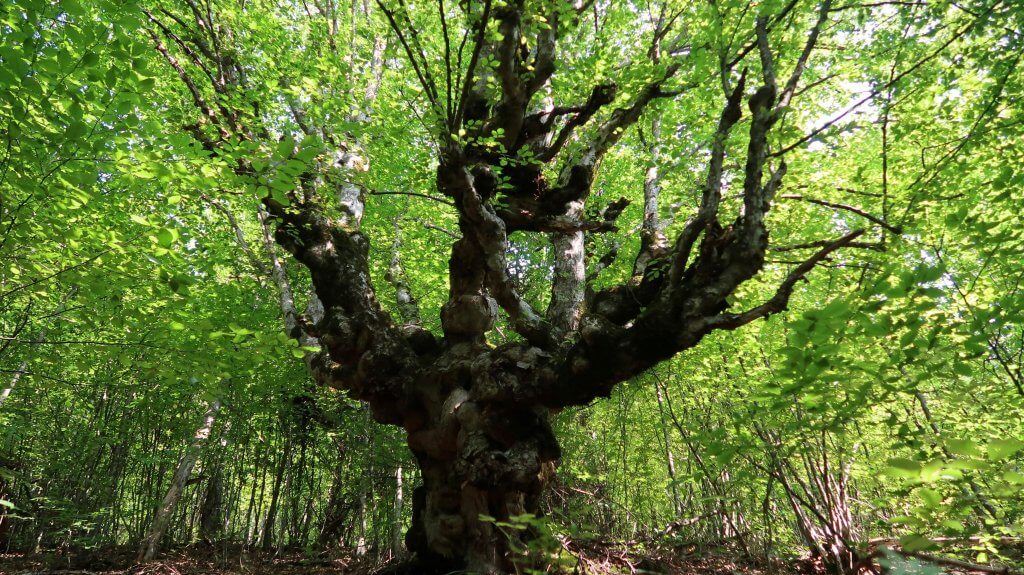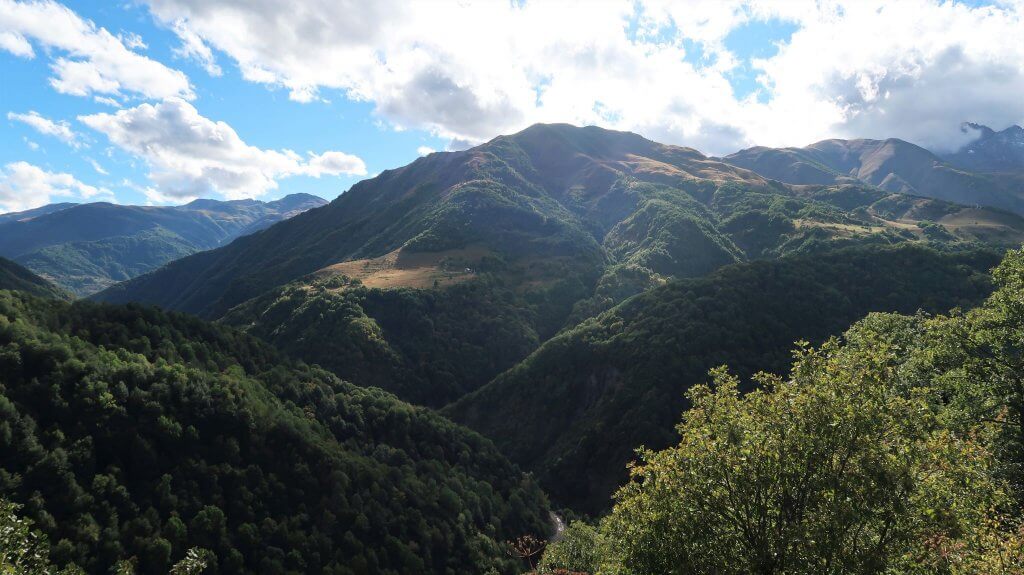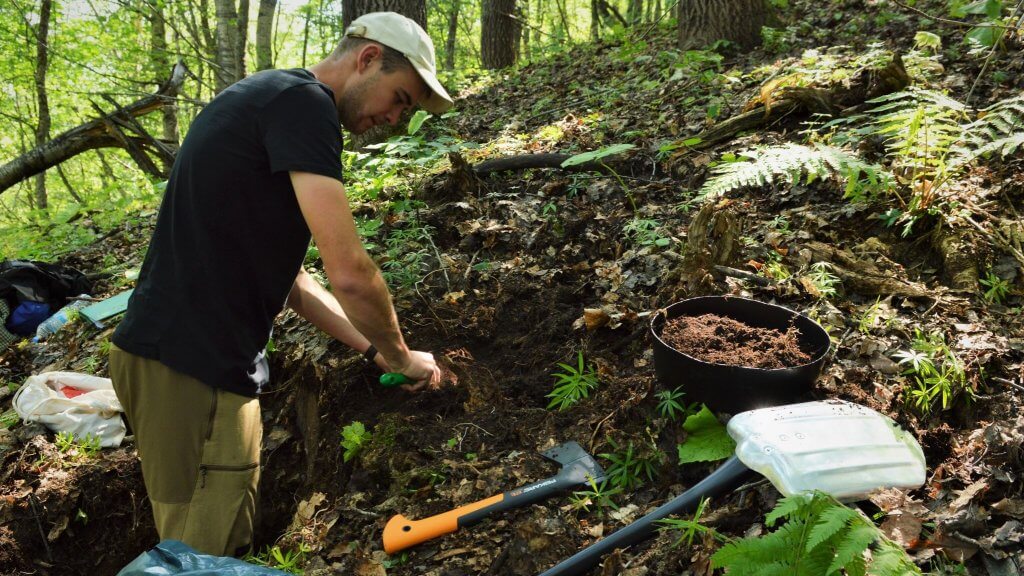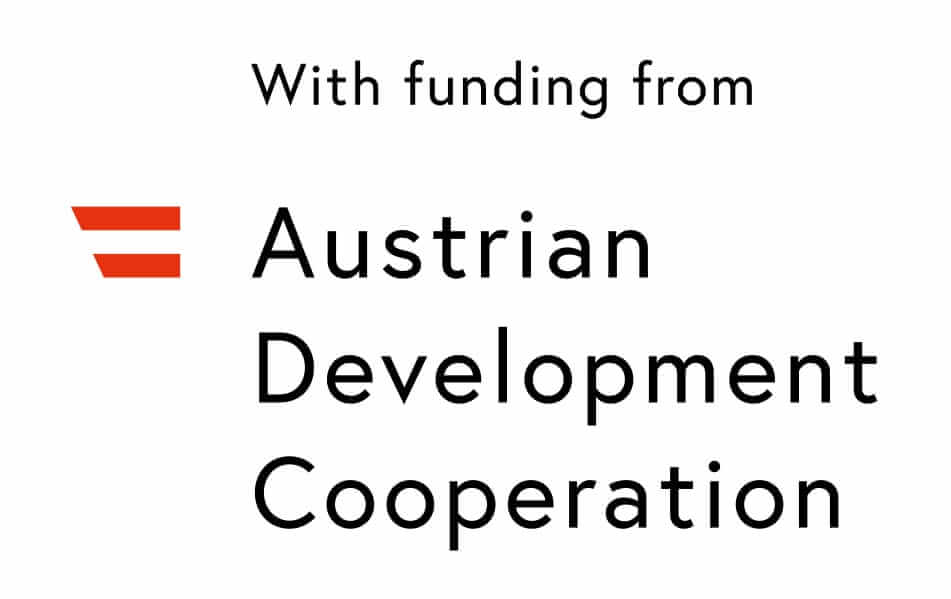Georgia’s Aragvi – a newly established protected landscape area (PLA) of almost 100,000 hectares – is located in three separate valleys about 80 km north of the Georgian capital Tbilisi. “We are working in an area with harsh winters, sultry summers and herds of thousands of cattle. The area has a long history of settlement. Evidence of this can be seen in the fruit trees, which are scattered even at high altitudes, or the head trees, which are individuals whose branches were regularly cut to provide fodder or fuel for the local people. We know of similar tree shapes in our country, for example in the dowsing willows, but in Aragua these are mostly beeches or hornbeams. The steep slopes are covered with a varied mix of native broadleaf species, sometimes turning into grassland or rhododendron stands. The forests, which cover about 42 % of the area, occur at altitudes ranging from about 840 to 2 000 metres above sea level,” said Pavel Peška from the Institute of Forest Botany, Dendrology and Geobiocenology.
Scientists across the region took over 200 vegetation records of existing forest and shrubland. As part of the vegetation survey, they conducted typological assessments on most plots, including soil probes from which they collected samples. “From this data, the main basic vegetation units for the whole MPA were extracted, characterised and mapped using statistical methods. To reconstruct the potential vegetation and historical tree composition, we have chosen a pedoanthracological method using the carbon accumulated in the soil after forest fires. The great diversity of native tree species in the area is evidenced by the fact that we recorded a total of 32 tree species in the tree and 74 in the shrub layer in the surveyed areas,” said Veronika Kalníková from the Agency for Nature and Landscape Protection of the Czech Republic, Administration of the Beskydy Protected Landscape Area.
The inventory of the forests in Aragua had to be carried out in view of the very rugged and sometimes inaccessible terrain using a method in which the inventory plots are concentrated in clusters of three areas 150 metres apart. “The centres of the plots are fixed, which allows the inventory to be repeated in the future and changes in space and time to be assessed. Especially from the Caucasus, one of the world’s most important biodiversity hotspots, we should have data on ecosystem dynamics. Based on this inventory, we will now prepare a forest management plan,” commented Tadeáš Štěrba from the Institute for Forest Management in Brno on the Caucasus forest inventory.
The whole process aimed at the sustainability of forests in the Aragui region cannot do without facilities for the use and processing of wood, especially for the production of firewood and charcoal, which is relatively hard to obtain legally. “Charcoal production, in particular, has great potential, as the area is dominated by hardwoods, which are the most suitable for this purpose. Moreover, we already have positive experience with charcoal production from the implementation of a similar project in Mongolia,” said Štěrba.
For this purpose, one of the buildings of the former concrete plant was reconstructed with respect to the local morphology of local buildings. The operation of the wood warehouse will start after training of persons to operate the machines.



For the successful establishment of sustainable forestry in Aragua it is important that the local population understands the changes taking place; on the other hand, it is important for scientists to find out more about the lifestyle of the three ethnic groups that inhabit the Aragua Valley. “When we started the project, we conducted an opinion survey among the local population with a series of questions, such as whether they know that they live in the MPA, what impact it has on their lives, how much firewood is consumed per family per year, and what species of wood they prefer. Subsequently, we did an awareness campaign among local residents in the form of distributing leaflets to raise their awareness about the project and the activities themselves. We will repeat the same type of survey at the very end of the project. We also organize seminars and training sessions where we show what we have already done within the project and with what result,” Štěrba enumerated the outreach activities in Aragvi.
The scientists are also trying to arouse interest in forestry in the area among pupils of local schools. Later this year, they are planning demonstrations of forestry pedagogy and the making of a documentary film.
Contacts for more information:
Ing. Tadeáš Štěrba, head of the specialized department of forest typology at the Institute for Forest Management in Brno, project leader, +420 601 384 296; Sterba.Tadeas@uhul.cz
Ing. Veronika Kalníková Ph.D., botanist, AOPK ČR, Administration of the Beskydy Protected Landscape Area, deputy project leader and leader of the vegetation-typology group, +420 734 690 744, veronika.kalnikova@nature.cz
Ing. Pavel Peška, Institute of Forest Botany, Dendrology and Geobiocenology, LDF MENDELU, member of the vegetation-typology group, +420 775 960 819, pavel.peska@mendelu.cz
The four-year forestry-focused foreign development cooperation project is part of a comprehensive programme entitled “Sustainable development of the ARAGVI Protected Landscape Area and local communities”. The project is implemented by the Institute for Forest Management Brandýs nad Labem, in cooperation with Lesprojekt East Bohemia, AgoraCe and with the support of MENDELU. The main partners of the project in Georgia are the public law legal entities National Forestry Agency and Agency of Protected Areas, Dusheti Municipality, Agricultural University of Georgia.
The project is implemented under the auspices of the Czech Development Agency and the Austrian Development Agency.


More news
-
The Horizon Europe project, Eurasian Network for Collaborative Research on Tree-Root-Mycorrhizal-Pathogen Interactions in Forest Soils (EuAsiaN-ROOT), coordinated by the Faculty of Forestry and Wood Technology, aims to provide a deeper…24. 6. 2025
-
Five Female Wolves Fitted with GPS Collars in the Beskydy and Javorníky…
Researchers from the Faculty of Forestry and Wood Technology at Mendel University in Brno have successfully captured and fitted GPS telemetry collars on five female wolves in the Beskydy and Javorníky Mountains over the past two years. These…28. 5. 2025 -
FFWT launches unique data collection on forest ecosystem functioning in MENDELU…
The Department of Forest Ecology at the Faculty of Forestry and Wood Technology of Mendel University in Brno (FFWT MENDELU), in cooperation with the Masaryk Forest Training Enterprise at Křtiny (ŠLP Křtiny), has launched monitoring of selected…23. 5. 2025 -
Professor Vladimír Tesař on the 30th anniversary of Pro Silva Bohemica: focus…
The Faculty of Forestry and Wood Technology and other stakeholders commemorated the thirtieth anniversary of Pro Silva Bohemica, an association of foresters dedicated to promoting close-to-nature forest management. Professor Emeritus Vladimír Tesař…9. 5. 2025 -
Scientists aim to determine which tree species have the most significant…
An international team studying the growth of 223 tree species across 160 experimental forests worldwide has found that conservative tree species—efficiently conserving resources such as nutrients, water, and energy—tend to grow faster under natural…16. 4. 2025 -
FFWT and UFE Křtiny partners of the ForDiL project supporting the education of…
The Faculty of Forestry and Wood Technology, Mendel University (FFWT MENDELU) and the University Forest Enterprise Masaryk Forest Křtiny (UFE Křtiny) are the main partners of the ERASMUS+ project Forest of the future: digital tools for learners to…11. 4. 2025 -
FFWT MENDELU and UFE Křtiny hosted Belgian students within the Erasmus+…
The students from Institut Technique Horticole de Gembloux were hosted by the Faculty of Forestry and Wood Technology, Mendel University (FFWT MENDELU) and the University Forest Enterprise Masaryk Forest Křtiny (UFE) as part of the Erasmus+ short…7. 4. 2025 -
Student Design 2025: the Upholstery Craft Award goes to MENDELU
The Student Design 2025 competition, held at the Mobitex fair at the Brno Exhibition Centre, awarded the works of students from secondary schools and universities from the Czech and Slovak Republics. The Upholstery Craftsmanship Award went to…2. 4. 2025 -
Pigeons' behaviour and habits in Brno: Research by the Faculty of Forestry and…
The Department of Forest Conservation and Wildlife Management at the Faculty of Forestry and Wood Technology (FFWT) has been conducting research on urban wildlife for more than two years. One part of the research focuses on wild pigeons,…26. 3. 2025 -
FFWT MENDELU participates in Diplomacy Week
The Faculty of Forestry and Wood Technology of Mendel University (FFWT MENDELU) is participating in Diplomacy Week, which takes place from 24 to 28 March 2025 in the Czech Republic. On this occasion, the Deputy Ambassador of Bosnia and Herzegovina…18. 3. 2025